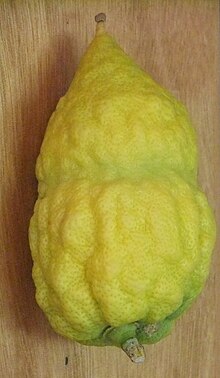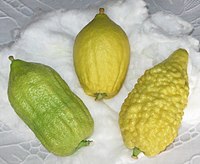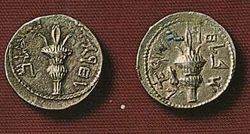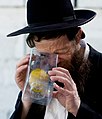Etrog

Etrog (Hebrew: אֶתְרוֹג, plural: etrogim; Ashkenazi Hebrew: esrog, plural: esrogim) is the yellow citron or Citrus medica used by Jews during the week-long holiday of Sukkot as one of the four species. Together with the lulav, hadass, and aravah, the etrog is taken in hand and held or waved during specific portions of the holiday prayers. Special care is often given to selecting an etrog for the performance of the Sukkot holiday rituals. [1]
Etymology
The
Taxonomy
| Citron varieties |
|---|
 |
| Acidic-pulp varieties |
| Non-acidic varieties |
| Pulpless varieties |
| Citron hybrids |
| Related articles |
In Modern Hebrew, etrog is the name for any variety or form of citron, whether kosher for the ritual or not. In general usage, though, the word is often reserved to refer only to those varieties and specimens used ritually as one of the four species. Some taxonomic experts, like Hodgson and others, have mistakenly treated etrog as one specific variety of citron.[8][9] The various Jewish rites utilize different varieties, according to their tradition or the decision of their respective posek.
Biblical references
On the first day you shall take the fruit of majestic trees, branches of palm trees, boughs of leafy trees, and willows of the brook; and you shall rejoice before the Lord your God for seven days.
—Leviticus23:40, New Revised Standard Version
While the biblical phrase peri eitz hadar (פְּרִי עֵץ הָדָר) (translated above as "fruit of majestic trees") may be interpreted or translated in a number of ways, the Talmud derives that the phrase refers to the etrog.
In modern Hebrew, hadar refers to the genus
Historical cultivation
Etrogim were extensively cultivated in the
Archaeological evidence for Citrus fruits is limited, as neither seeds nor pollen are likely to be routinely recovered in archaeology.[10] The earliest evidence of etrogim in Israel is the 2012 discovery of citron pollen from the second century BCE in excavations at the Ramat Rachel site.[11]
In diaspora
After the fall of Jerusalem in 70 CE, exiled Jews planted citron orchards wherever the climate allowed: in Southern Europe (Spain, Greece, and Italy) as well as in North Africa and Asia Minor. Jews who settled north of the warmer citron-growing areas depended on imported etrogim, which caused much anxiety given the dangers and uncertainties of sea travel. By the seventeenth century, some of the most popular sources for etrogim were the islands of Corsica and Corfu.[citation needed]
Since the late 1850s, the Fruit of the Goodly Tree Association in Mandatory Palestine represented etrog farmers who marketed their crops to Jews in Europe. Some Jewish communities still preferred citrons from Italy, Greece, Morocco, or Yemen, but many Jews seeking citrons turned back to Eretz Yisrael, the land of Israel.
American Jews continue to import the majority of their holiday etrogim from
Cosmetic requirements
Pitam
A pitam or pitom (Hebrew: פיטום; plural pitamim) is composed of a style (Hebrew: "דַד" dad), and a
Pitam preservation technique
Many more pitamim are preserved today due to an
Experimenting with picloram in a laboratory, Goldschmidt eventually found the correct "dose" to achieve the desired effect: one droplet[clarification needed] of the chemical in three million drops of water.[14][page needed]
Purity
In order for a citron to be kosher, it must be neither grafted nor hybridized with any other species. Only a few traditional varieties are therefore used. To ensure that no grafting is performed, preferred plantations are kept under strict rabbinical supervision.
Genetic research

The citron varieties traditionally used as etrog are the Diamante citron from Italy, the Greek citron, the Balady citron from Israel, the Moroccan and Yemenite citrons.
A general DNA study was conducted by Eliezer E. Goldschmidt and colleagues which tested and positively identified twelve famous accessions of citron for purity and being genetically related.[15]
The
Selection and cultivation
In addition to the above, there are rabbinical indicators used to distinguish pure etrogim from possible hybrids. These traditional indicators have been preserved by continuous
The most accepted indicators are: 1) a pure etrog has a thick rind, contrasting with its sparing pulp
A later and not as widely accepted indicator is the orientation of the seed. In a pure etrog, the seeds are oriented vertically, unless crowded by neighboring seeds; in lemons and hybrids, the seeds are oriented horizontally even when they are not crowded.[18]
The etrog is typically grown from cuttings that are two to four years old. The tree begins to bear fruit about four years after planting the cuttings.
Customs

To protect the etrog during the holiday, it is traditionally wrapped in silky flax fibers and stored in a special decorative box, often made from silver.[21]
After the holiday, eating the etrog or etrog jam is considered a .
Etrogim grown in Israel are not classified as food and are therefore not recommended to be eaten due to the large amount of pesticides used in their agriculture.[24]
Gallery
-
Rabbi Bergman re-examines an etrog for a student
-
RabbiDov Landauinspecting an etrog
-
Balady citron inBnei Berakmarket
-
Yanova etrog for sale
-
Cross section of Diamante citron, to check for genetic purity
-
Mature fruit of Yanover etrog
-
Cross section of Braverman etrog
-
Cross section in Yemenite citron
-
Cross section of Greek citron
-
Cross section of Balady citron
-
Cross section of a Moroccan citron
-
Yemenite citron (left) and a Balady citron (right)
-
Cross section ofvariety etrogcitron, and in fingered citron.
-
Diamante citron without pitam
-
Diamante citron with pitam
-
Inspecting an etrog for flaws
-
Inspecting a Yemenite citron
-
Shmita inKefar Chabad, orchard left untended
-
Young plants in Kefar Chabad
-
Yemenite citron on tree
-
Etrog covered with cloves
-
Four species market in Tel Aviv
-
Pitam close-up
-
Etrog blossom
-
Etrog tree fromJewish Encyclopedia
-
Man in Mea Shearim inspecting etrog
-
Moroccan etrog with prominent gartel
-
AtWestern wall
-
German painting
-
Two Hasidim inBnei Berak
-
Old photo of grower
-
An etrog from many angles
-
Round silver etrog box
-
Etrog with half-dried pitam
-
Etrog plants in nursery
-
Etrog leaves
-
Citron (etrog) flowers
-
Silver etrog box designed by Rabbi Chaim-Joseph-Meyer Elefant (1897-1976) in the early 1950s
See also
References
- ^ "In Calabria, rabbis and farmers continue a 2,000-year-old etrog tradition | the Times of Israel". The Times of Israel.
- ^ The Citrus Industry Archived March 8, 2008, at the Wayback Machine
- ^ Moster (2018), p. 24.
- ^ "Jerusalem Dig Uncovers Earliest Evidence of Local Cultivation of Etrogs". Haaretz. Retrieved 2022-10-10.
- ISBN 0-253-35493-5.
- ^ Hadith no. 288, Book 6 of the Sahih Muslim - via Sunnah.com
- ^ Moster (2018), p. 25.
- ^ Nahon, Peter (2015-06-01). "Les Agrumes d'Intérieur : des variétés historiques aux essais actuels". Fruits Oubliés.
- ^ "ethrog". www.citrusvariety.ucr.edu. Archived from the original on 2015-06-08. Retrieved 2008-04-15.
- )
- ^ First evidence of the etrog tree in Israel
- ^ "America's Only Etrog Farmer Isn't Even Jewish". Tablet Magazine. 2011-10-12. Retrieved 2022-10-10.
- ^ Wall, Alix (2016-10-14). "The elegant, elusive etrog: Growing the symbol of Sukkot in California". J. Retrieved 2022-10-10.
- JSTOR 2441301– via JSTOR.
- ^ Search Authentic Citron Archived 2019-01-26 at the Wayback Machine
- A brief documentation of this study could be found at the Global Citrus Germplasm Network Archived 2008-04-10 at the Wayback Machine.
- ^ Article by Professor Goldschmidt, published by Tehumin, summer 5741 (1981), booklet 2, p. 144
- Shmuel Yehuda Katzenellenbogen of Padua from the mid-16th century, printed in Teshuvat ha'Remochapter 126.
- Orach Chaimchapter 648, comment 23
- ^ Chiri, Alfredo. (2002). Etrog Archived April 4, 2005, at the Wayback Machine
- ^ "Sunkist Website". Archived from the original on October 17, 2007.
- ^ "The Saga of the Citron". Reform Judaism.
- ISBN 9657108519.
- ^ "Redirecting..." www.aish.com. Archived from the original on 2020-03-01. Retrieved 2008-01-31.
{{cite web}}: Cite uses generic title (help) - ^ "זהירות: למרות הסגולות מסוכן לאכול ריבת אתרוגים". סרוגים (in Hebrew). 2011-10-24. Retrieved 2020-09-29.
- Moster, David Z. (2018). Etrog: How a Chinese Fruit Became a Jewish Symbol. ISBN 978-3-319-73735-5.
Further reading
External links
 Media related to Etrog at Wikimedia Commons
Media related to Etrog at Wikimedia Commons- The Citrus Variety Collection Archived 2015-06-08 at the Wayback Machine by the University of California Riverside
- Ancient Treasures and the Dead Sea Scrolls
- Mosaic depicting an etrog
- Lulav, Etrog, Shofar and Menorah, 2nd Cent. CE, Ostia Synagogue
- An antique Hebrew coin depicting an etrog
- Pictures homecitrusgrowers.co.uk
- Evyatar Marienberg and David Carpenter, The Stealing of the "Apple of Eve" from the 13th century Synagogue of Winchester[permanent dead link], Henri III Fine Rolls Project, Fine of the Month: December 2011
- A Huge Etrog-looking Citron in Geetha's Kitchen, amazing photos
- Know Your Etrog, website with educational pictures, information how to plant your own tree.
- The Symbolism of the Lulav and Esrog, various sources explaining the symbolism and meaning of the etrog.








































